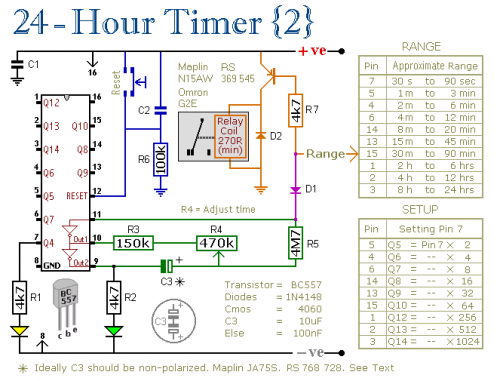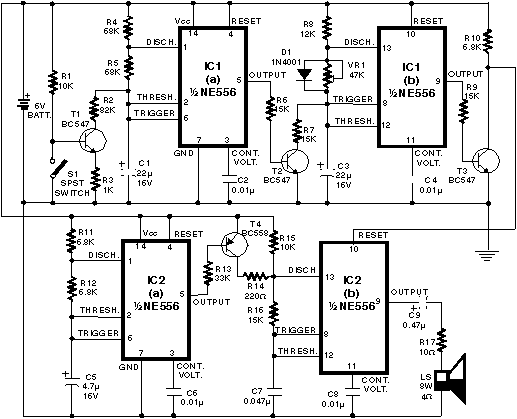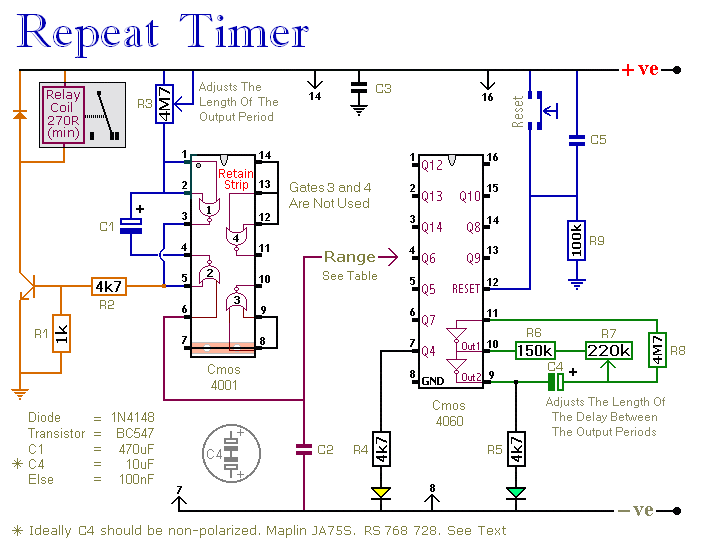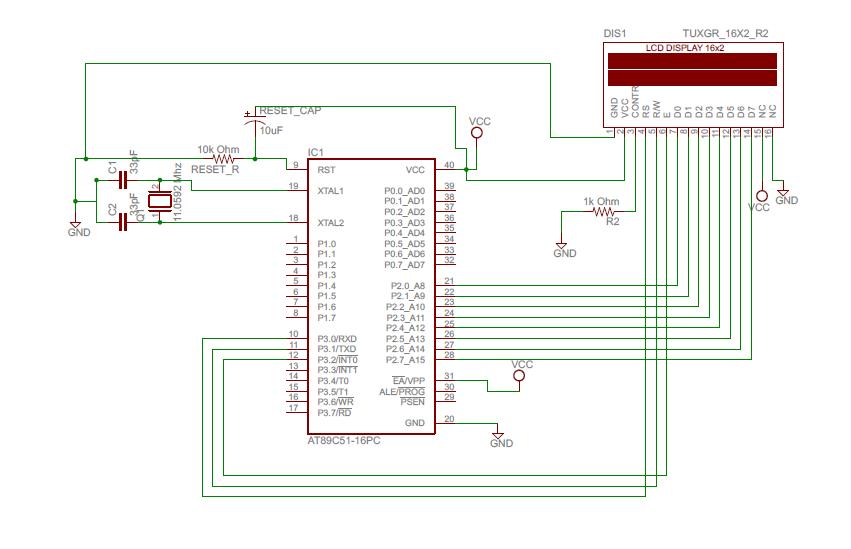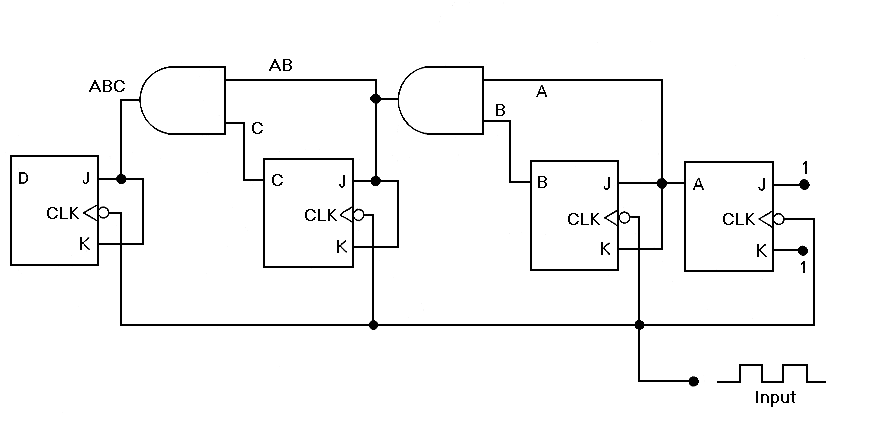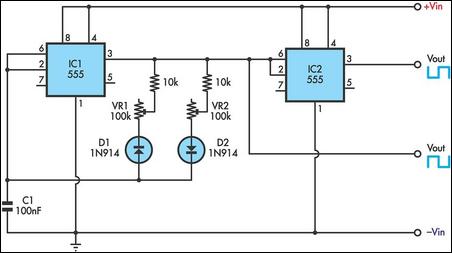
Timers and Counters in AT89S52
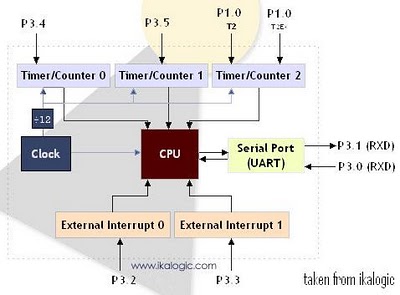
The diagram below illustrates a simplified representation of the main peripherals present in the 89S52 microcontroller, which is part of the 8052/8051 family. The 89S52 includes three Timers/Counters. The term "Timer/Counter" is applicable because this unit can function either as a counter or as a timer based on the requirements. Timer/Counter 2 is a specialized counter that exhibits different functionality compared to the other two. The serial port utilizes a UART (Universal Asynchronous Receive Transmit) protocol, making it suitable for various communication applications. The UART in the 89S52 facilitates communication with a computer equipped with a serial port, as well as with other microcontrollers. Furthermore, all the aforementioned peripherals can generate interrupt signals for the CPU in response to specific events. Additionally, there are two external interrupt sources (INT0 and INT1) that allow for the generation of interrupt signals from external devices, such as sensors or Digital to Analog converters.
The 89S52 microcontroller is equipped with three Timers/Counters, which are essential for various timing and counting operations within embedded systems. Each Timer/Counter can be configured to operate in multiple modes, providing flexibility for different applications. The first two Timers/Counters can be utilized for standard timing functions, such as generating precise delays or measuring time intervals, while Timer/Counter 2, with its unique capabilities, can serve specialized counting functions or operate in a different timing mode.
The UART interface is a critical component of the 89S52, enabling asynchronous serial communication. This interface allows the microcontroller to communicate with peripheral devices, including computers and other microcontrollers, over a serial connection. The UART supports various baud rates, ensuring compatibility with different communication standards. This feature is particularly beneficial for applications that require data exchange between multiple devices, such as sensor networks or remote monitoring systems.
The interrupt functionality of the 89S52 enhances the responsiveness of the microcontroller to external events. With the ability to generate interrupts from the internal peripherals as well as external sources, the microcontroller can efficiently handle time-sensitive tasks. The external interrupt sources (INT0 and INT1) are designed to respond to signals from external devices, allowing for real-time processing of inputs from sensors or other digital devices. This capability is crucial for applications such as event-driven systems, where immediate action is required based on external conditions.
Overall, the combination of versatile Timer/Counters, a robust UART interface, and multiple interrupt sources makes the 89S52 microcontroller a powerful tool for various embedded applications, providing the necessary resources for efficient data processing and communication.Diagram below shows a simplified diagram of the main peripherals present in the 89S52 or 8052 / 8051. There are 3 Timers/Counters in the 89S52. The expression "Timer/Counter" is used because this unit can act as a Counter or as a Timer as per requirement.
Timer/Counter 2 is a special counter that does not behave like the two others, because of some extra functionality. The serial port, using a UART (Universal Asynchronous Receive Transmit) protocol can be used in a wide range of communication applications. With the UART provided in the 89S52 it is easy to communicate with a serial port equipped computer, as well as communicate with another microcontroller.
If all the peripherals described above can generate interrupt signals in the CPU according to some specific events, it can be useful to generate an interrupt signal from an external device that may be a sensor or a Digital to Analog converter. For that purpose there are 2 External Interrupt sources (INT0 and INT1). Posted by Muhammad Ahmed on 16:33. Filed under Counters, How Stuff Works, Microcontroller, Timers. You can follow any responses to this entry through the RSS 2. 0. Feel free to leave a response 🔗 External reference
The 89S52 microcontroller is equipped with three Timers/Counters, which are essential for various timing and counting operations within embedded systems. Each Timer/Counter can be configured to operate in multiple modes, providing flexibility for different applications. The first two Timers/Counters can be utilized for standard timing functions, such as generating precise delays or measuring time intervals, while Timer/Counter 2, with its unique capabilities, can serve specialized counting functions or operate in a different timing mode.
The UART interface is a critical component of the 89S52, enabling asynchronous serial communication. This interface allows the microcontroller to communicate with peripheral devices, including computers and other microcontrollers, over a serial connection. The UART supports various baud rates, ensuring compatibility with different communication standards. This feature is particularly beneficial for applications that require data exchange between multiple devices, such as sensor networks or remote monitoring systems.
The interrupt functionality of the 89S52 enhances the responsiveness of the microcontroller to external events. With the ability to generate interrupts from the internal peripherals as well as external sources, the microcontroller can efficiently handle time-sensitive tasks. The external interrupt sources (INT0 and INT1) are designed to respond to signals from external devices, allowing for real-time processing of inputs from sensors or other digital devices. This capability is crucial for applications such as event-driven systems, where immediate action is required based on external conditions.
Overall, the combination of versatile Timer/Counters, a robust UART interface, and multiple interrupt sources makes the 89S52 microcontroller a powerful tool for various embedded applications, providing the necessary resources for efficient data processing and communication.Diagram below shows a simplified diagram of the main peripherals present in the 89S52 or 8052 / 8051. There are 3 Timers/Counters in the 89S52. The expression "Timer/Counter" is used because this unit can act as a Counter or as a Timer as per requirement.
Timer/Counter 2 is a special counter that does not behave like the two others, because of some extra functionality. The serial port, using a UART (Universal Asynchronous Receive Transmit) protocol can be used in a wide range of communication applications. With the UART provided in the 89S52 it is easy to communicate with a serial port equipped computer, as well as communicate with another microcontroller.
If all the peripherals described above can generate interrupt signals in the CPU according to some specific events, it can be useful to generate an interrupt signal from an external device that may be a sensor or a Digital to Analog converter. For that purpose there are 2 External Interrupt sources (INT0 and INT1). Posted by Muhammad Ahmed on 16:33. Filed under Counters, How Stuff Works, Microcontroller, Timers. You can follow any responses to this entry through the RSS 2. 0. Feel free to leave a response 🔗 External reference
